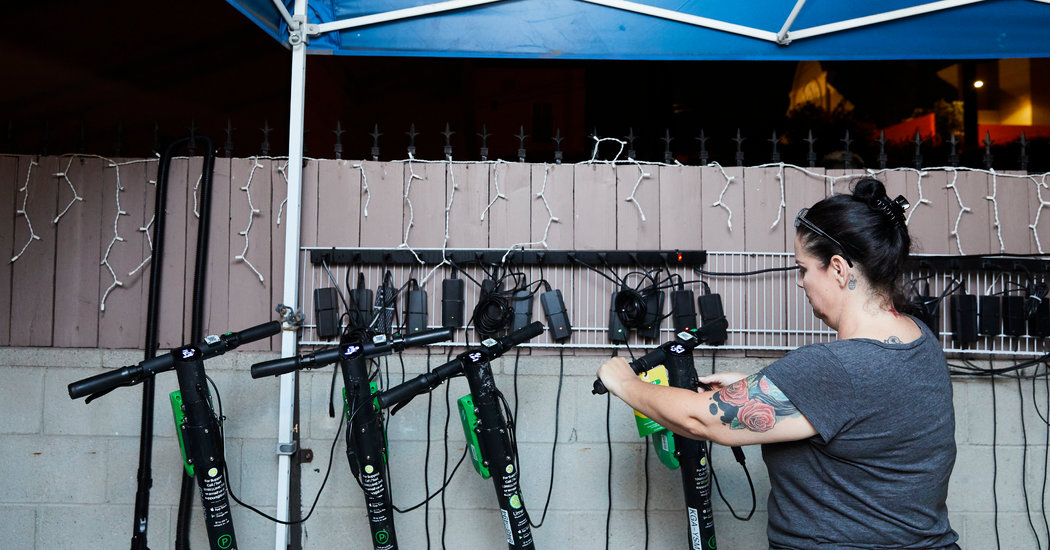LOS ANGELES — Michelle and Gonzalo Cabezas start their nightly scavenger hunt at 10. Which is when they start out on the lookout for the Lime scooters that people hire and experience by the minute — and leave where ever they remember to.
“People just take them to the darnedest spots,” Mrs. Cabezas stated from the passenger seat of her husband’s cargo van in northeast Los Angeles.
The Lime application was open on her Iphone, navigating toward the night’s initially bounty, a sideways scooter a couple houses from their own driveway. They’d receive $4.50 to choose up and recharge it.
Drive down most key streets in Los Angeles and it is an impediment course of Skittles-coloured mobility gadgets: eco-friendly Limes, yellow Bolts, red Bounce bicycles.
8 on-desire e-scooter and e-bike businesses are permitted to function in the city, and soon after a handful of rides, they all will need juice.
Mr. and Mrs. Cabezas are among the Lime’s military of “juicers”: impartial contractors who indicator up to charge scooters through the exact same app that riders use to rent them.
Out on their mission, Mr. Cabezas scanned the scooter’s QR code with his wife’s cell phone and loaded the Lime in the van. Then they had been off to the subsequent one particular, two blocks away in an alley. And a further, around the corner in a community park. They picked up 16 scooters in an hour to cost at house, earning $67.
San Francisco-based Lime hires about 60,000 freelance juicers in the 100 marketplaces the place it operates. The organization pays $3 to $10 per scooter that is retrieved, recharged and then introduced in “deployment zones” of its picking out.
Across the country, in dozens of metropolitan areas, start off-ups are conducting a grand experiment in two-wheeled, electric powered-driven urban mobility. And nowhere is that experiment more grand than in Los Angeles, exactly where Lime operates 5,000 of the 37,500 scooters and e-bikes that the metropolis is testing as element of the country’s major dockless mobility software.
Robert Cartwright is a charger for Bird, a Santa Monica corporation that started off the e-scooter craze two decades back. It operates in 100 cities around the world and, like Lime, farms out its recharging to any one 18 or more mature with a smartphone and a willingness to do it.
He moved to Los Angeles from Ohio a thirty day period ago in pursuit of a audio job and commenced doing the job as a charger “to make a great deal of income rapid,” he stated. “If you do it every working day, you can make $40,000 a year.”
Mr. Cartwright doesn’t individual a vehicle. He takes advantage of a Hen scooter to get other Birds, in some cases using five at a time stacked like a pinwheel to just take them again to his condominium for recharging. The moment their batteries are whole, he borrows a friend’s auto to drop them off in the “nests” the place Chook needs them.
For every single one, he makes about $6. He also does “move tasks” for $2 every single, driving a scooter from an obscure spot to a much more in-desire location close to general public transit hubs or together walkable thoroughfares with nicely-trafficked enterprises.
In complete, he will make about $160 a day. That’s similar to an Uber driver, “only you do not got to offer with people or discuss to folks,” Mr. Cartwright said.
These operations make up one of the lesser-acknowledged functions in the gig financial system. But it’s proving valuable for some of the 1000’s who do it some chargers report creating as significantly as $50 an hour.
It isn’t devoid of its issues. On my generate with Mr. and Mrs. Cabezas, they employed the application to find two Lime scooters at an condominium creating, only to find them locked at the rear of a gate. Yet another scooter was being loaded into a pickup truck just as the couple drove up.
There are also hoarders, who travel close to picking up scooters figuring out that they will sooner or later will need recharging, even if the scooter organization hasn’t nonetheless posted them to the application. And then there are the scooters that have a flat tire or are someway broken and call for a exclusive trip to a repair-it locale.
The occupation necessitates a lot more than just figuring out the application. Earning it lucrative implies comprehending the city well more than enough to know if a tantalizing cluster of scooters is in a harmful spot. Also understanding the place to park, due to the fact there is no less difficult way to wipe out a night’s earnings than acquiring a highly-priced ticket.
There’s also the upfront tools expense. New juicers spend Lime $10 per charger. Mr. and Mrs. Cabezas stated they experienced spent about $250 for the two dozen chargers they employed, quite a few purchased secondhand.
Continue to, Mr. and Mrs. Cabezas reported it was well worth their time. Functioning 3 or 4 nights a week, the few have designed about $5,000 considering that May perhaps, with very little used out of pocket. They said that their electric power bill experienced risen about $10 a month and that they used about $5 in gas every single evening.
As much these gigs may possibly be a boon to the employees, there are thoughts about the mobility programs’ environmental and economic sustainability. A new examine from North Carolina Condition College located that driving around to decide up, recharge and release the scooters accounted for 40 p.c of a scooter’s full greenhouse fuel emissions.
On regular, chargers drive in between a half mile and two-and-a-fifty percent miles for every scooter, said Jeremiah Johnson, one particular of the study’s authors. About 17 percent of the scooters picked up for recharging did not have to have it they even now experienced 95 per cent of their demand.
“The charging itself, the electric power when you plug it in, is basically quite compact — just 5 percent of the overall burdens,” he stated.
And then there are the economics.
It expenditures less than 10 cents to recharge a scooter, according to ARK Make investments, an investment decision administration business targeted on disruptive innovation. ARK researched the viability of the scooter financial state this yr and found that the authentic expense in charging was not electricity but relocating the scooters to popular spots.
ARK observed that scooter companies ended up creating $2.43 per mile in profits but spending $2.55 for each mile to retain the scooters functioning. If organizations utilized drivers for Uber and Lyft to shift scooters, they could save $1.03 a mile, ARK reported.
Uber and Lyft offer scooters via their ride-hailing applications, and both organizations tackle their have recharging. A Lyft formal said its program “means that our team specifically controls and oversees all elements of functions, which includes drop-off, pickup, charging, cleaning and repairing — all inside a community warehouse.”
Cities’ embrace of scooters has not generally been easy. Because September 2018, Santa Monica has been working a pilot program with 3,000 permitted scooters. A calendar year before, when Chicken kicked off the scooter revolution by leaving them parked devoid of authorization, there ended up some “initial issues about people pirating electrical energy on celebration,” the town supervisor, Rick Cole, said. “People who mentioned, ‘Hey, any person plugged into my outlet.’” Those problems ended up minor, he explained, and dealt with on a scenario-by-situation foundation.
The more substantial problem has been making certain that the recharged scooters usually are not remaining in parts the place they are a hazard. In Los Angeles, the wrestle is placing far more scooters in very low-profits communities underserved by public transit.
“Are they deploying in a way that is not above-deploying in some neighborhoods and underserving other folks?” claimed Seleta Reynolds, common supervisor of the Los Angeles Division of Transportation.
The company forecasts 16 million e-scooter and e-bicycle journeys in the metropolis this calendar year, and is functioning with the firms to make certain the scooters are left in proper areas.
“It’s not perfect by a prolonged shot,” Ms. Reynolds reported. “These businesses are mastering in real time just as we are.”







Leave a Reply